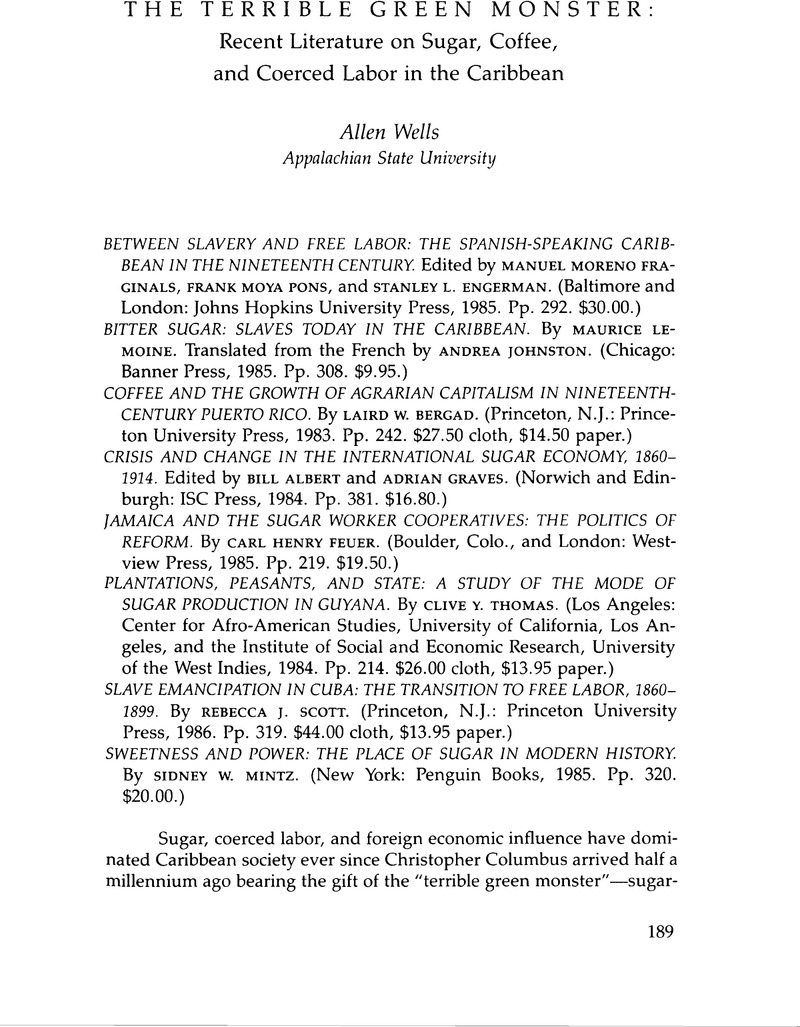No CrossRef data available.
Published online by Cambridge University Press: 12 October 2022

1. Manuel Moreno Fraginals, “Plantations in the Caribbean: Cuba, Puerto Rico, and the Dominican Republic in the Late Nineteenth Century,” in Moreno Fraginals et al., Between Slavery and Free Labor, 3–21. Another useful survey of some of the radical changes of the sugar industry during the nineteenth century is Christian Schnakenbourg's “From the Sugar Estate to Central Factory: The Industrial Revolution in the Caribbean (1840-1905),” in Albert and Graves, Crisis and Change, 83–93.
2. This encouraging dialogue is directly attributable to Moreno Fraginals, whose prize-winning three-volume masterpiece has captured the imagination of Caribbeanists. Moreno Fraginals's original version of El ingenio was published in 1964, then was translated in 1976 and published as The Sugarmill: The Socioeconomic Complex of Sugar in Cuba, 1760-1860 by Monthly Review Press. In 1978 a completely revised three-volume edition was published in Cuba. See El ingenio: complejo económico social cubano del azúcar, 3 vols. (Havana, Editorial de Ciencias Sociales, 1978). For a stimulating review of the revised work, see Franklin W. Knight, “The Caribbean Sugar Industry and Slavery,” LARR 18, no. 2 (1983):219-29.
3. This quotation by Moreno Fraginals is cited in Rebecca J. Scott, Slave Emancipation in Cuba, 77.
4. Eugene D. Genovese, Roll, Jordan, Roll: The World the Slaves Made (New York, 1974); Herbert Gutman, The Black Family in Slavery and Freedom, 1750-1925 (New York, 1976); and Leon Litwack, Been in the Storm So Long: The Aftermath of Slavery (New York, 1979).
5. Genovese, Roll, Jordan, Roll, 6.
6. Ibid., 5.
7. Robert S. Starobin, Industrial Slavery in the Old South (New York, 1970). See Scott's discussion in Slave Emancipation in Cuba, 26–28.
8. Moreno Fraginals, El ingenio, 1:308-9; cited in Scott, Slave Emancipation in Cuba, 28.
9. For a more rigorous definition of slavery, see Orlando Patterson, Slavery and Social Death (Cambridge, Mass., 1982), chap. 1.
10. Francisco A. Scarano, Sugar and Slavery in Puerto Rico: The Plantation Economy of Ponce, 1800-1850 (Madison, 1984). See also Andrés A. Ramos Mattei, La hacienda azucarera: su crecimiento y crisis en Puerto Rico (siglo XIX) (San Juan, 1981).
11. For example, see Angel G. Quintero Rivera, Conflicto de clase y política en Puerto Rico (Río Piedras, 1976); and Quintero Rivera, “Background to the Emergence of Imperialist Capitalism in Puerto Rico,” in Puerto Rico and Puerto Ricans: Studies in History and Society, edited by Adalberto López and James Petras (New York, 1974), 87–117.
12. Bergad and Tom Brass have been carrying on a running debate on labor conditions in Puerto Rico. See Bergad, “Coffee and Rural Proletarianization in Puerto Rico, 1840–1898,” Journal of Latin American Studies (hereafter cited as JLAS) 15, pt. 1 (May 1983):83-100; Brass, “Coffee and Rural Proletarianization: A Comment on Bergad,” JLAS 16, pt. 1 (May 1984):143-52; Bergad, “On Comparative History: A Reply to Tom Brass,” JLAS 16, pt. 1 (May 1984):153-56; and Brass, “Free and Unfree Labour in Puerto Rico during the Nineteenth Century,” JLAS 18, pt. 1 (May 1986):181-94.
13. Treacle is the English term for molasses.
14. Peasants' broadsheet cited in Michael T. Taussig, The Devil and Commodity Fetishism in South America (Chapel Hill, N.C., 1980), 93–94.
15. Caribbeanists have long debated the impact of the plantation on modern development, especially the adversarial relationship between the dual worlds of the sugar monoculture and the peasantry. For two contrasting views, see George L. Beckford, Persistent Poverty: Underdevelopment in Plantation Economies of the Third World (New York, 1972); and G. B. Hagelberg, The Caribbean Sugar Industries: Constraints and Opportunities (New Haven, 1974). Knight includes an interesting discussion of the debate in “The Caribbean Sugar Industry,” 219–22.
16. See also Clive Y. Thomas, The Threat and the Promise: An Assessment of the Impact of Technological Development in the High Fructose Corn Syrup and Sucro-Chemical Industries (Trinidad, 1982); idem, Dependence and Transformation: The Economics of the Transition to Socialism (New York, 1974); idem, Sugar Economics in a Colonial Situation: A Study of the Sugar Industry in Guyana (Georgetown, Guyana, 1970); and idem, Monetary and Financial Arrangements in a Dependent Monetary Economy (Mona, Jamaica, 1965).